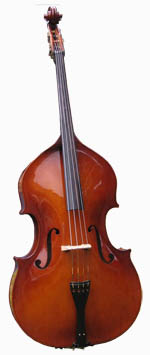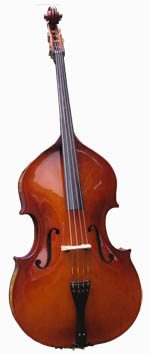 This week we’re looking at the original bass: precursor to the bass guitar and the largest instrument in the classical orchestra, it may not be the most portable of instruments, but it can certainly make its presence felt: the upright bass.
This week we’re looking at the original bass: precursor to the bass guitar and the largest instrument in the classical orchestra, it may not be the most portable of instruments, but it can certainly make its presence felt: the upright bass.
The upright is the daddy of all basses. It’s also known as “string bass” – or “double bass” in orchestral circles. You can think of it as a giant violin; the construction is very similar. The upright bass is tuned in fourths: E, A, D, G, like the lowest four strings of a guitar, but an octave lower (this makes it the odd man out in the orchestra string section, where the other instruments are tuned in fifths).
Arco Playing
The string bass is a versatile instrument. You can play it with a bow, like a violin, to produce sustained notes. Impress your classically trained friends by calling this technique arco.
First let’s listen to each string in turn:
And now a simple musical phrase:
Putting on the Pizz
In jazz and most styles outside of classical, the strings are actually plucked with the finger rather than bowed – called “pizzicato”, classical terminology fans.
Again, we’ll start with each string in turn:
And then a phrase:
A note on listening
Laptop speakers often have trouble accurately reproducing bass frequencies. If you are listening on a laptop, use headphones or hook up some speakers. If you need further advice on audio equipment for ear training, try my earlier series, “Wired for Sound”.
Slap that bass!
In rockabilly and bluegrass, bassists often play with a slap style (not to be confused with the electric bass slap technique, coming up later) where they pull the strings back aggressively, causing them to slap against the fingerboard and create a percussive sound. This technique works particularly well in groups without a drummer, as it adds a additional rhythmic element to the group’s sound.
One of my favorite bands including upright bass is the Western swing / hot jazz group, “Hot Club of Cow Town,” who feature some ridiculously great bass playing – check the short bass solo at 1:50!
An easy way to hear the difference between an upright and an electric bass is to listen for “gliss” notes (where the bassist plays one note and then slides to the next). On an upright, they move smoothly like a violin or trombone, on an electric bass they move in semitones like sliding your finger up a piano.
In this sample, listen to the way that the notes slide smoothly from one to the next.
Don’t think that just because the upright bass has been around for a few hundred years it doesn’t have a place at the cutting edge. Upright bass is a frequent ingredient in drum and bass, and the jazz-influenced breakbeats of Ninja Tune.
But before you rush out to buy one…
There is no doubt an upright bass is a wonderful thing. The sheer size and physicality of the instrument is something everyone should experience, and the powerful vibrations flowing through the instrument give you a wonderful sense of connection to the music. (Not to mention spinning a double bass on its endpin while playing is one of the most fun things you can do with your clothes on!)
Compared to instruments you might find in a rock band they can, however, be very expensive. An acquaintance of mine who played bass in an orchestra once told me she had totaled her car in an accident, but it wasn’t so bad because her bass was unharmed. I could hardly believe this, but then she pointed out that her car had been worth less than a thousand pounds, but the bass was worth well over ten thousand!
Also, not everyone can find the room or the money for a full-size acoustic bass. Many musicians instead play the student’s ¾-size instruments as these tend to be cheaper – and also avoids the cramp-inducing 42-inch scale length!
Prior to the 1950s, the upright bass was the only game in town, but it was far from an ideal instrument for the working musician. Upright basses sound fantastic, but they are big, heavy, fragile, expensive, and not especially loud (an orchestra may require several playing in unison just to be heard). Perhaps worst of all, its fretless neck means it requires virtuoso ability to play rapid passages with a clean tone and perfect intonation.
Enter Leo Fender…
Next time we’ll be looking at the great man’s key contribution to the world of bass, without which we wouldn’t have all the wonderful basses we do today. More background info, more sound clips, more bass ear training – next time!









Love the car crash story!
In spite of their enormous size, the hollow wood construction of the double bass has always made them seem oddly vulnerable to me – especially when you see the player lugging them around the place… Perhaps I'm biased by playing electric guitar and sax growing up. Far sturdier instruments!
Here's a tale where the bass does not fare so well: http://doublebassblog.org/2011/03/a-tale-of-doubl…